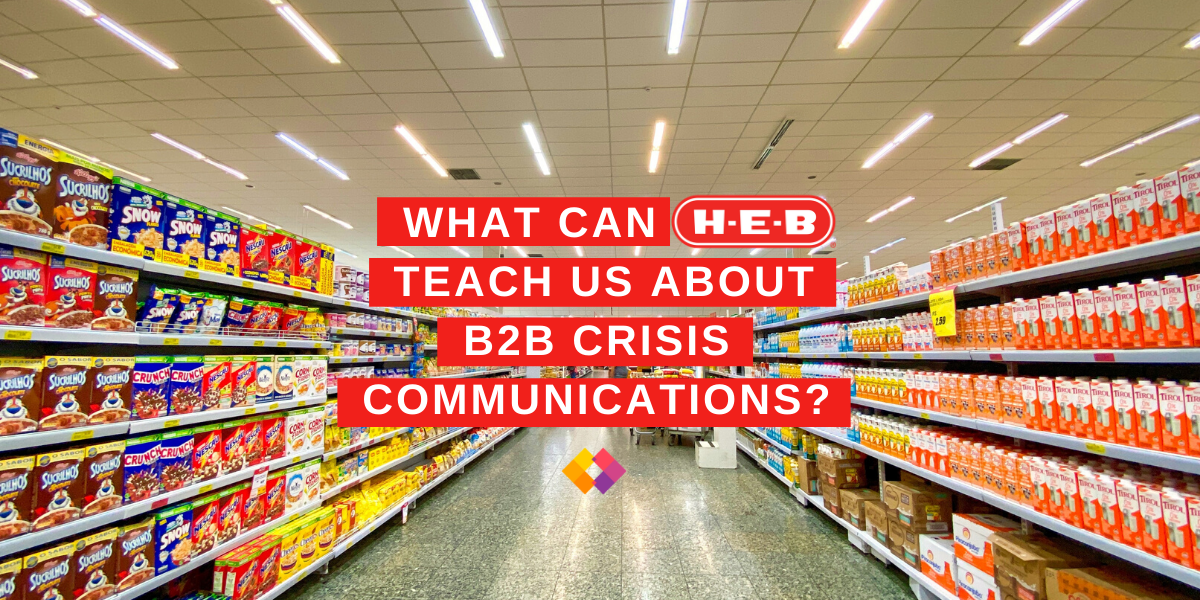If you’re from Texas (like me!) then you’re probably very familiar with H-E-B, a supermarket chain known for its great selection, friendly staff and top-notch community outreach. H-E-B is beloved throughout Texas not only for its great deals, but also for its community support and disaster relief during times of need.
During Hurricane Harvey for example, H-E-B was on the frontline with first responders, deploying mobile kitchens and a Disaster Relief Unit. It also supplied two water tankers throughout the city of Houston, which were integral in helping the Gulf recover from the devastation caused by the storm.
Its response to the current pandemic has been no different – H-E-B is once again on the frontlines and ahead of the curve. With the public expecting more than just a blanket statement from companies during periods of instability, what can H-E-B’s approach teach us about crisis communications and how can it be applied to the b2b world?
Have a crisis plan in place before disaster hits
Texas Monthly reported that H-E-B began to prepare for COVID-19 in January based off a H1N1 pandemic plan the company formed in 2015. In times of crisis, it’s always best to have a plan in place. Crisis communications strategies should be proactive and focus on a company’s response and how it will disseminate information to its employees, partners, customers, media, the public, and any other valuable stakeholders.
In b2b PR, having a detailed crisis plan in place prior to an issue saves both time and resources in the long run, while also ensuring that everyone involved is on the same page when it comes to messaging and strategy. Companies – particularly those in b2b – should never try to “wing it” during distressing times, as there’s nothing worse than a company appearing like it doesn’t know what it’s doing. Customers will be paying extra attention to how you respond, with the impact of one false step potentially being felt long after the crisis has passed.
Avoid coming across as self-serving in your crisis response
The way companies respond to a scandal or crisis can often come off as disingenuous or self-serving. In early March while most brands were struggling to implement crisis plans and preparing for layoffs, H-E-B began making adjustments both internally and externally. It limited the amounts of certain products customers could purchase, implemented social distancing in-store and limited store hours to make restocking easier.
H-E-B also extended its employees sick leave policy and created a coronavirus hotline for employees in need, while giving all staff an additional $2-an-hour pay raise. This strategy has not only kept business running smoothly during the pandemic, but also showed the public that H-E-B cares about its customers and employees.
While it can be difficult to find that balance when suffering a major financial hit, those working in b2b should consider a strategy that highlights the company’s offerings without coming across as a sales pitch. They should focus on authentic actions that add value, rather than just trying to get their name in the conversation.
Be clear in your messaging
It’s always important to be clear in your messaging so nothing gets misconstrued or lost in translation. B2b brands must be wary of releasing too much information too soon and ultimately confusing people, or providing too little information and leaving people wondering what your company is planning. Capitalizing on social media is a must during a crisis, as that’s the fastest and most efficient way to push out updates to the public.
H-E-B describes itself as a “purpose-driven” company and this is evident in the consistent and open engagement it has used with customers and employees. On March 4, H-E-B activated its Emergency Operations Center in San Antonio and began conducting daily meetings with leaders of impacted areas and various departments within the company to shape strategy and messaging. Since that time, it has been vigilant in disseminating messaging outlining its safety implementations throughout all stores and resources available to customers and employees in need. Crises may come and go, but clear and consistent brand messaging is always essential.
During a crisis, there are always plenty of examples of what not to do. Companies invariably make mistakes when handling crisis situations, which can result in them suffering long-term consequences. As we are currently in the midst of a worldwide pandemic, we have experienced countless examples of this over the past few months – just turn on the news to see firsthand how corporations and governments are stumbling through COVID-19.
On the other hand, there are companies – like H-E-B – that have implemented well thought out crisis communications plans. The common thread thoughout the most successful companies is that they not only tackle crises head on, but also rely on proactive and transparent approaches that ultimately elevate their status in the eyes and hearts of consumers.
Do you need help developing a crisis communications plan? Get in touch at hello@rlyl.com to find out how we can support you.



